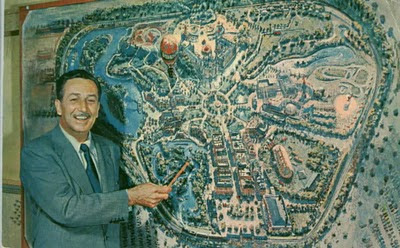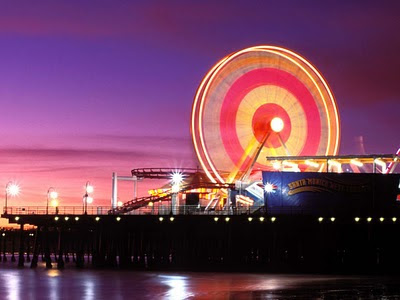 In 1955 Walt Disney opened the first modern theme park in Anaheim, Calif. The meticulous showman made sure that every detail was carefully engineered, down to the ticket pricing. The 1955 Disneyland admission was a modest $1. That's about $8 in today's dollars — and yes, it's vastly cheaper than today's adult admission price of $72. The park also sold tickets, costing 10 to 35 cents, for rides. The tickets were offered in books so that a family could purchase a book once and tear out tickets as needed. Psychologically, the tickets were a guilt-free currency. You weren't spending money, you were simply tearing tickets out of a book. America's families thought it was a fantastic deal — so much so that one huckster charged $5 to let overflow crowds in via a ladder.
In 1955 Walt Disney opened the first modern theme park in Anaheim, Calif. The meticulous showman made sure that every detail was carefully engineered, down to the ticket pricing. The 1955 Disneyland admission was a modest $1. That's about $8 in today's dollars — and yes, it's vastly cheaper than today's adult admission price of $72. The park also sold tickets, costing 10 to 35 cents, for rides. The tickets were offered in books so that a family could purchase a book once and tear out tickets as needed. Psychologically, the tickets were a guilt-free currency. You weren't spending money, you were simply tearing tickets out of a book. America's families thought it was a fantastic deal — so much so that one huckster charged $5 to let overflow crowds in via a ladder. In 1982, Disneyland dispensed with the ride tickets. Of course, you still had to pay $12 admission (about $27 in 2010 dollars). Over the past 28 years, the admission has more than doubled in real terms.
In 1982, Disneyland dispensed with the ride tickets. Of course, you still had to pay $12 admission (about $27 in 2010 dollars). Over the past 28 years, the admission has more than doubled in real terms.That's starting to have an effect. A recent Los Angeles Times article reports that Disney's theme parks saw a 7 percent drop in revenue for 2008-2009. Meanwhile, recession-weary families are returning to the Ferris wheel and boardwalk parks that some, including Walt himself, thought obsolete.
Small, privately owned seaside parks, such as Pacific Park at the pier in Santa Monica, Belmont Park in San Diego and the Santa Cruz Beach Boardwalk, don't have multimillion-dollar advertising campaigns or 3-D attractions as do Disneyland and Universal Studios Hollywood. But they boast something even more appealing to penny-pinching tourists: Free admission.…
Pacific Park on the Santa Monica Pier, for example, offers 12 rides on 2 acres of sun-baked boardwalk. But in 2009, it drew nearly $18 million in revenue, a 5% increase over the previous year, on top of a 5% increase in 2008.
"In this economy, we've actually done OK," said park spokesman Jeff Klocke.…
"We came here because it didn't cost anything," said Leila Nightingale, a tourist from England, who visited the park with her friend Jessica Townsend. "We are traveling around the world and we are trying to save money."
 "Free" is the eye of the beholder. Small parks are free as long as you don't get on any rides. The Disney parks are free once you get past the turnstile. Behavioral economists have long been aware of a so-called flat-rate bias. Since surrendering hard-earned cash is unpleasant, we prefer to do it as little as possible — as if gulping down a distasteful medicine. Disneyland's post-1982 pricing is a perfect example of flat-rate pricing. Pay once and get the bad part over with — then everything is free! This appealing thought is also the basis of unlimited calling plans, health club memberships, Netflix, and luxury cruises' "free" food.
"Free" is the eye of the beholder. Small parks are free as long as you don't get on any rides. The Disney parks are free once you get past the turnstile. Behavioral economists have long been aware of a so-called flat-rate bias. Since surrendering hard-earned cash is unpleasant, we prefer to do it as little as possible — as if gulping down a distasteful medicine. Disneyland's post-1982 pricing is a perfect example of flat-rate pricing. Pay once and get the bad part over with — then everything is free! This appealing thought is also the basis of unlimited calling plans, health club memberships, Netflix, and luxury cruises' "free" food. At his park's opening Walt Disney dedicated a plaque reading: "Disneyland is dedicated to the ideals, the dreams and the hard facts which have created America." As I remark in my book Priceless, the flat-rate bias figures prominently in the American dream of home ownership. Americans love owning a nice home in the suburbs and driving everywhere in private cars. It isn’t that owning is cheaper than renting, necessarily. It’s just that with renting the cost is more apparent. (“All you’ll end up with is a pile of rent receipts!”) Many urbanites would find it cheaper to sell their SUV and take taxis everywhere. But the thought of paying $15 cab fare to go to the supermarket is unconscionable. No one likes to hear the taxi meter running.
So where did the Disney parks go wrong? Obviously, admission prices have gone up a lot faster than inflation. The reason isn't hard to fathom. Today's Disneyland is a very different place from the 1955 version. The original park was low-key affair with no thrill rides. Expectations were different. To the teacup ride's first patrons, Disney's 1951 animated Alice in Wonderland was cutting-edge entertainment. Today's park has to stand up to Tim Burton's $250 million 3D extravaganza. Disneyland costs a lot more to run these days, and that has to be passed on. A family of four can pay $268 or more. Even the cleverest psychological pricing can't soft-pedal that.
That's just the price to get into the park. I recently hear their profit per head is more than Las Vegas now. They make their money on the backend, cross-selling and up-selling each visitor with overprices balloons, toys, and other junk that are bought on impulse. (was just there with 2 kids a few months ago, the memory still haunts me)
ReplyDeleteI don't know if they're priced appropriately or not but they're getting people into the park that have the money to spend once they get inside. The seaside parks don't have that.